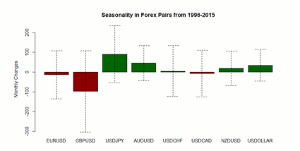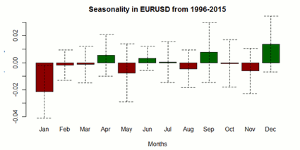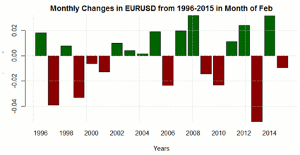Christopher Vecchio of DailyFX.com outlines how and why—for February—he’s expanded his forex focus on the period of 1996 to 2015 in recognition of the evolving relationship between economic data, central banks, and financial markets.
Talking Points:
- February marks the second month of the strongest quarter of the year for the US dollar.
- The commodity currencies have typically outperformed during February.
- February marks the start of four consecutive months of gains for the S&P 500 (SPX).
See the full rundown of seasonal patterns broken down by currency pairs below.
That was a rough first week of February for the US dollar. After interest rate markets priced out any rate hikes by the Federal Reserve this year, the greenback slid across the board, with Wednesday, February 3, marking the single-largest one day drop for the ICE Dollar Index in history outside of the 1998 and 2008 crises. Needless to say, markets have proven unsettled with the US dollar’s prospects, so much so that otherwise bullish longer-term seasonality trends have thus far been ignored.
Yet now that rate hikes by the Fed in 2016 have been priced out, there may be a floor in expectations in place; the US dollar’s otherwise bullish seasonality trends may prove helpful if a rebound or period of stabilization takes shape through the end of the month, particularly against the European currencies.
For February, we have expanded our focus on the period of 1996 to 2015 in recognition of the evolving relationship between economic data, central banks, and financial markets. The longer observation period captures several crisis events/periods that traders may find analogous to events unfolding today: the Asian crisis; the US tech bubble; the housing bubble; the commodity bubble; and previous rate hiking and rate cutting cycles, from the major central banks, during times normal (pre-2008) or extraordinary (post-2008). By increasing the sample size to 20 years, we believe the statistical stability of the estimates will have increased relative to utilizing a shorter time-frame/smaller sample size.
Forex Seasonality in Euro (via EUR/USD)
February is a neutral month for EUR/USD, from a seasonality perspective, due to its inconsistent performance metrics. The pair has appreciated 55% of the time in February over the past 20 years, yet its average performance during this time frame is -18.3-pips per month. Positive years have only produced modest gains, while negative years have produced slightly greater losses. To see the remaining charts and read the entire article click here…
By Christopher Vecchio, Currency Analyst, DailyFX.com





















